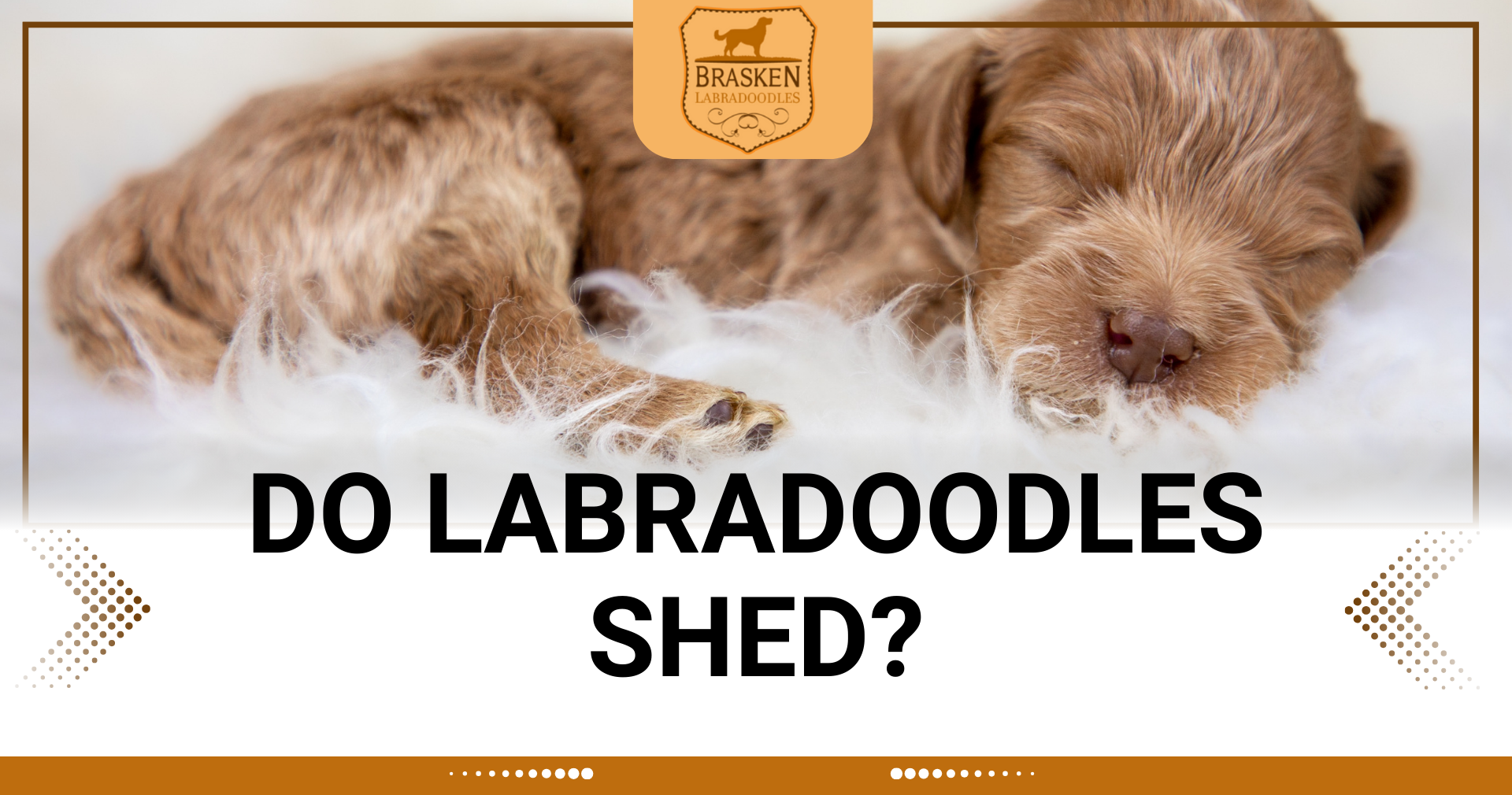One of the most complex puzzles potential pet parents try to solve is choosing the right breed. We get many questions from families looking to adopt: Do Labradoodles shed? We’ll shed some light on this mystery immediately; they do shed, but not nearly as much as other breeds, making the labradoodle a superb choice for those who want to avoid a house full of dog hair.
It’s important to remember that while these fluffy pups have a knack for keeping their coats to themselves, they are not completely hypoallergenic. That doesn’t indicate that you will need a full-time housekeeper to keep your home free of hair. Neither will you sneeze around the clock, but you should be prepared for light shedding. So, to all potential Labradoodle parents, make peace with the occasional stray hair here and there.
Origin Of Labradoodles
Labradoodles hail from the land down under—Australia, to be precise. According to the Australian Labradoodle Association, a visionary breeder aimed to create a non-shedding dog by crossing a Standard Poodle (known for its low shedding) with a Labrador Retriever (renowned for its trainability).
It happened in the 1900s when labradoodles were meant to be guide dogs. Though they didn’t hit the hypoallergenic bullseye perfectly, they did land a high spot in the popularity charts, and hence, the loveable Labradoodle was born.
Australian Labradoodles tend to be more consistent in their traits. These traits reflect the original Labradoodle. Early generation Labradoodles can be different as their genes are diverse. The two breeds are still nearly identical. You can train both types to be service dogs.
There are different Labradoodle types depending on the poodle-to-Labradoodle gene ratio. F1 Labradoodles feature half of both a labrador retriever and a poodle. F2 and F1b Labradoodles feature higher ratios of poodle genes. As such, they’re more likely to be hypoallergenic dogs. None of these types are purebred dogs.
Labradoodle Coat Types
The Labradoodle’s coat is Mother Nature’s masterpiece—a unique blend of its parent breeds. Each Labradoodle sports a variety of coats, with the texture ranging from wiry to silky soft. They can have a straight coat, more like their Labrador Retriever parent, or a more curly coat, reminiscent of the poodle. You’ll also notice variations in coat color.
Do not be surprised if the puppy coat metamorphoses into an entirely different adult coat when your Labradoodle puppy becomes an adult. Daily brushing is recommended, especially for Labradoodles with wavy or curly coats.
Wool
Wool coats for Labradoodles are like haute couture in the doggie world. These coats mimic the posh poodle coat and are ideal for allergy sufferers as they are more hypoallergenic and low-shedding.
Having a Labradoodle with a wool coat at home is similar to having a live, walking, wagging teddy bear; bracing yourself for tons of cuddles is a smart move!
Fleece
The fleece coat, or shaggy yet chic look, is typical in Labradoodles. These coats boast a wavy texture, evolving from a gentle wave to a tight curl, giving Labradoodles a dreamy, bohemian vibe.
Even though fleece-coated Labradoodles still shed, the volume is much less than one would expect from shedding breeds, making their owner’s life less of a ‘hairy’ affair! All they need on the maintenance front is thorough grooming once a week, and occasional professional grooming depending on how you like to keep their coats.
Hair
Lastly, the hair coat type in Labradoodles is something to look out for. This type is often in the early generation Labradoodles. It is straight out of the Labrador gene pool. Straight-haired Labradoodles are a no-no for allergy sufferers.
While this coat may shed more than the other two, Labradoodles with curly hair coats are still far less ‘sheddy’ than many other family pets and remain popular.
How Often Do Labradoodles Shed?
Shedding in Labradoodles is like twilight—it’s there, but you may need to pay attention to notice it. It’s nothing as severe as shedding in Golden Retrievers, German Shepards, Cocker Spaniels, or Irish Water Spaniels. Even Labrador Retrievers are known for their seasonal shedding, but thanks to the Poodle genes, Labradoodles don’t shed as much, or don’t have seasonal shedding. Whew, a big relief, right?
Nevertheless, regular grooming, preferably weekly brushing, and occasional help from a professional groomer can significantly help control the shedding and your anxiety levels.
If you have a dog allergy, stick to Australian Labradoodles. Remember, owning a Labradoodle may not give you tons of exercise from non-stop vacuuming, but you’ll enjoy some ‘couch potato’ prevention from a fair amount of grooming!
What Triggers Shedding?
Shedding can be considered the doggie version of an emotional scratch pad or organic thermometer. Stress, skin conditions, genetics, or seasonal allergies can make your Labradoodle lose more hair than usual. Imagine your Labradoodle’s fur reacting to life scenarios like our heart rate. Now, here’s the rundown of individual triggers:
Genetics
Just like humans, Labradoodles come with their own set of genetic codes, some of which control their fur growth. Sometimes, these genes get a little fibbly and cause the sweet pooch to shed more than is cute.
Remember, your Labradoodle’s genetic makeup plays a massive role in how much they shed, so don’t appear surprised when they decide to donate some of their fluff to your carpet!
Grooming
Various factors can control how much a Labradoodle sheds, such as the care and attention given to the dog’s coat. Grooming helps control shedding, so unattended fur growth could amplify shedding. It’s like weeding a garden; the better you tend to it, the fewer unwanted sprouts you get. For optimal grooming tips, consult a vet or professional pet groomer.
Health
Let’s face it: As adorable and affectionate dogs, Labradoodles have their share of potential health issues. Some of these contribute to shedding, like certain food allergies or reactions to specific dog shampoos.
Stress
Like a barometer for emotions, dogs shed more when they’re stressed. A Labradoodle left alone for extended periods may experience stress and anxiety, leading to fur loss.
Changes in routine or introducing new furry members can also spur shedding. But don’t worry. Such stress-induced shedding seldom lasts more than a fortnight. Your dog’s coat should bounce back to its fluffy glory without intervention.
Allergies
Nature’s packed with allergens; even your lovely Labradoodles can’t dodge them. Something as common as grass can trigger Labradoodle shedding, mainly if it occurs seasonally.
Dog allergies are like a magnifying lens, focusing the symptoms on the skin and coat. Keep an eye out for increased shedding during allergy season because, like us humans, dogs may also get the sniffles!
Fleas & Parasites
Little freeloaders like fleas and parasites can lead to your Labradoodle shedding excessive fur. Since these tiny troublemakers are hard to spot, you might notice more fur balls around the house than on your dog!
Vet recommended flea treatments can treat fleas, and a vet can diagnose and manage parasite-related problems. Keeping your Labradoodle pest-free will undoubtedly take a load off their fur!
Infections
That fluffy Labradoodle can be hit with a pesky skin infection, sparking an avalanche of shedding. Take yeast dermatitis, for instance. This happens when the acidity level on your dog’s skin flips the balance scale due to diet changes, medication, or some illnesses, and it can lead to extra shedding. It becomes urgent to pay attention when a furry friend starts to drop fur after alterations in their routine.
How To Reduce Shedding
Brace yourself; your Labradoodle will shed, and you can’t stop that. But never fear; you’ve got some tricks up your sleeve to minimize it! To keep your environment fur-free, get into a routine of brushing and combing your Labradoodle at least once a week; even better if you can manage twice.
Get a de-matting rake or a wide-tooth comb to make this task easier. You might feel uncertain about how to groom your Labradoodle in the beginning properly, but you’ll get the hang of it. Also, getting trigger-happy with your vacuum cleaner wouldn’t hurt. It’s a great way to keep those loose strands in check and maintain a tidy home.
Brush Regularly
Labradoodles, sporting a mix of fur types, often face a hairy matting situation, which can be unpleasant. Gearing up with a slicker brush and a metal comb, regularly brushing your dog’s coat is key to liberating it from painful matting. Remember, you must comb through every inch of your dog’s coat.
Failure to do so can accumulate dead hair and irritate your dog’s skin, prompting your Labradoodle to shed more. So, go ahead, soar through your labradoodle’s coat with the brush, and then get down to skin level with your comb for that salon finish.
Regular Bathing
Maintaining a regular bathing routine can be a game-changer when caring for your Labradoodle’s coat. Being a breed with sensitive skin, sticking to shampoos designed for sensitive skin or even those with colloidal oatmeal can help keep that skin soft and nourished. But remember, moderation is the key!
Washing your dog more than once every eight weeks can throw off the pH balance of its coat and stimulate shedding. You don’t want to irritate your dog’s skin. Proper moisturization also reduces dander.
Proper Nutrition
Even your Labradoodle can’t resist the innate dog instinct to devour everything in sight. Although commercial pet food offers a balanced diet, ensure that you choose the right dry food to cater to your pup’s nutritional requirements while caring for their skin and coat. Firstly, avoid any drastic diet changes. Slowly transition to new dog food over 4-5 days, especially if your pup has just moved to a new home.
Supportive Supplements
While their diet should ideally cover all their nutritional needs, enriching your Labradoodle’s diet with some beneficial supplements doesn’t hurt. For instance, feeding them omega-3 fatty acid supplements can significantly boost their coat health.
Keep track of their shedding habits. Watch out for excessive shedding, and check your labradoodle’s diet to ensure it has stayed the same. If everything seems normal, but your Labradoodle is shedding excessively, it might be time to consult a veterinarian. Remember, regular brushing goes a long way in the shedding business!
The Takeaway
Remember that prevention is better than cure regarding the Labradoodle shedding conundrum. Dog owners need to keep that brush and comb handy. Devote at least 20 minutes weekly to brushing your dog’s beautiful coat.
Keeping the coat healthy and shiny helps reduce shedding. Get those brushes out, and let the grooming session become a bonding time with your beloved pet!
About Brasken Labradoodles
For almost two decades, Brasken Labradoodles has been recognized by the ALAA as one of the best Labradoodle breeders in California. The dedication of Kristin & Brandon to the well-being and care of their Labradoodles showcases their passion for these affectionate and intelligent animals, ensuring each puppy is raised with love and expertise. Their commitment reflects in the healthy, happy, and well-socialized puppies that become cherished members of their new families.

